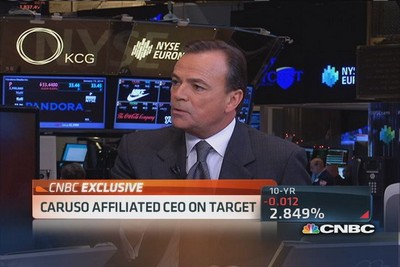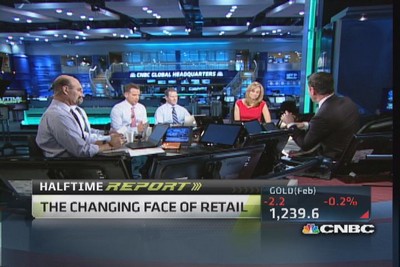The Self-Reinforcing Death Spiral of Retail (January 22, 2014)
Retail CRE is highly leveraged and loaded with staggering amounts of debt that rests on leases that are only as good as the retailers' profit-loss statements and solvency.
The decay of the "build it and they will come" model of commercial real estate is gathering speed for a simple systemic reason: the decline is self-reinforcing in several critical ways.
Before we start the analysis, let's ask a basic question: How much of the stuff and services purchased at retail outlets, malls, strip malls, etc. is absolutely necessary and how much is excess consumption?
Conventional "Growth by any means" Cargo Cultists such as Paul Krugman never ask this basic question, because the answer (very little is essential, most is excess consumption) undermines the entire narrative that all growth is good, even the most marginal, unsustainable, wasteful and fiscally imprudent.
I've captured the essence of retail in America with this photo:

Put another way: what if Degrowth is the future, for a variety of structural reasons? If so, the need for billions of square feet of commercial space will implode.
Degrowth, Anti-Consumerism and Peak Consumption (May 9, 2013)
Looming U.S. Retail Implosion: DeGrowth 2014 (December 4, 2013)
There are two primary self-reinforcing dynamics in retail CRE (commercial real estate): consumerist and financial. Let's start with the consumerist dynamic, which is composed of several interlocking feedback loops.
1. As the cost of big-ticket household expenses such as healthcare, energy, college, etc. rises while real income declines for the bottom 90%, households have less disposable income to spend on excess consumption--another tattoo, skinny-triple-mocha-fudge-lattes, 13th pair of shoes, etc.
I addressed the decline in real income yesterday in The First Domino to Fall: Retail-CRE (Commercial Real Estate).
2. The rise of eCommerce is eroding the desire to drive to the mall, strip mall, etc. when the goods can be delivered to one's door by the Brown Truck Store (Mark G.'s phrase).
3. As anchor chain stores and other key retailers reduce inventory and slash investment in maintenance and store improvement, the attractiveness of these physical places declines dramatically. Shopping in a decaying sepulchral cavern with little inventory on the shelves is not very appealing.
4. As chains close anchor stores in malls, foot traffic declines and the feeding chain of smaller retailers starves. The "cool/fun" factor of a mall declines exponentially with store closings. It's just not much fun to stroll through a huge space filled with closed storefronts and few other shoppers. In fact it can be a quite depressing experience.
The financial self-reinforcing dynamics are equally pernicious. Correspondent Chris H. (U.K.) recently described the precarious dependence of property valuations on long-term leases:
The primary point here is that CRE is highly leveraged and loaded with staggering amounts of debt that rests on leases that are only as good as the retailers' profit-loss statements and solvency.
As Mark G. noted in his overview After Seven Lean Years, Part 2: US Commercial Real Estate: The Present Position and Future Prospects, the standard commercial real estate loan is not a 30-year mortgage; it's a short-term mortgage ( 5 to 10 years) with a huge balloon payment that's due at the end of the term--a balloon payment that requires refinancing.
That need to refinance will force lenders to examine mall owners' leases and the valuations that are based on high occupancy and lease rates. As anchor tenants vacate and smaller tenants close up in their wake, how many of these retail properties will justify their previous valuations? What happens to these properties when the balloon payment can't be paid because the owners cannot refinance?
There are three other financial factors to consider:
1. Many of the healthiest malls are "premium outlets" that cater largely to foreign tourists and the dwindling class of upscale American households. Should a global recession occur, tourism will take a hit, along with the ability of foreign tourists to buy thousands of dollars of luxury brand handbags, etc.
2. Since the top 10% of U.S. households is heavily dependent on bonuses, ownership of stocks, real estate appreciation, etc. for their income gains, a rollover in equities and residential real estate would negatively impact the "wealth effect" that has powered their five-year long shopping spree.
3. Much of the "growth" reported by retailers has resulted from poaching existing store sales: The American Model of "Growth": Overbuilding and Poaching (November 19, 2013).
Once the wheels fall off this model of "growth," chains will enter a cycle of closing marginal stores to boost profits. That will place additional pressure on retail properties as once-reliable chain tenants exit marginal properties en masse.
http://www.oftwominds.com/blogjan14/dead-malls1-14.html
Retail CRE is highly leveraged and loaded with staggering amounts of debt that rests on leases that are only as good as the retailers' profit-loss statements and solvency.
The decay of the "build it and they will come" model of commercial real estate is gathering speed for a simple systemic reason: the decline is self-reinforcing in several critical ways.
Before we start the analysis, let's ask a basic question: How much of the stuff and services purchased at retail outlets, malls, strip malls, etc. is absolutely necessary and how much is excess consumption?
Conventional "Growth by any means" Cargo Cultists such as Paul Krugman never ask this basic question, because the answer (very little is essential, most is excess consumption) undermines the entire narrative that all growth is good, even the most marginal, unsustainable, wasteful and fiscally imprudent.
I've captured the essence of retail in America with this photo:

Put another way: what if Degrowth is the future, for a variety of structural reasons? If so, the need for billions of square feet of commercial space will implode.
Degrowth, Anti-Consumerism and Peak Consumption (May 9, 2013)
Looming U.S. Retail Implosion: DeGrowth 2014 (December 4, 2013)
There are two primary self-reinforcing dynamics in retail CRE (commercial real estate): consumerist and financial. Let's start with the consumerist dynamic, which is composed of several interlocking feedback loops.
1. As the cost of big-ticket household expenses such as healthcare, energy, college, etc. rises while real income declines for the bottom 90%, households have less disposable income to spend on excess consumption--another tattoo, skinny-triple-mocha-fudge-lattes, 13th pair of shoes, etc.
I addressed the decline in real income yesterday in The First Domino to Fall: Retail-CRE (Commercial Real Estate).
2. The rise of eCommerce is eroding the desire to drive to the mall, strip mall, etc. when the goods can be delivered to one's door by the Brown Truck Store (Mark G.'s phrase).
3. As anchor chain stores and other key retailers reduce inventory and slash investment in maintenance and store improvement, the attractiveness of these physical places declines dramatically. Shopping in a decaying sepulchral cavern with little inventory on the shelves is not very appealing.
4. As chains close anchor stores in malls, foot traffic declines and the feeding chain of smaller retailers starves. The "cool/fun" factor of a mall declines exponentially with store closings. It's just not much fun to stroll through a huge space filled with closed storefronts and few other shoppers. In fact it can be a quite depressing experience.
The financial self-reinforcing dynamics are equally pernicious. Correspondent Chris H. (U.K.) recently described the precarious dependence of property valuations on long-term leases:
The book value of the properties is based on the attainable rents. If just one property in the portfolio has to settle for a lower long-term rental rate, that will devalue the entire 'book to market' portfolio. Just a few low 'book to market' evidence-based valuations and the whole sector could collapse.
One way to dodge that bullet is to not offer any long-term leases. Another is to entice major tenants to sign high-value leases with various guarantees (that the mall will maintain a certain occupancy rate, etc.). The primary point here is that CRE is highly leveraged and loaded with staggering amounts of debt that rests on leases that are only as good as the retailers' profit-loss statements and solvency.
As Mark G. noted in his overview After Seven Lean Years, Part 2: US Commercial Real Estate: The Present Position and Future Prospects, the standard commercial real estate loan is not a 30-year mortgage; it's a short-term mortgage ( 5 to 10 years) with a huge balloon payment that's due at the end of the term--a balloon payment that requires refinancing.
That need to refinance will force lenders to examine mall owners' leases and the valuations that are based on high occupancy and lease rates. As anchor tenants vacate and smaller tenants close up in their wake, how many of these retail properties will justify their previous valuations? What happens to these properties when the balloon payment can't be paid because the owners cannot refinance?
There are three other financial factors to consider:
1. Many of the healthiest malls are "premium outlets" that cater largely to foreign tourists and the dwindling class of upscale American households. Should a global recession occur, tourism will take a hit, along with the ability of foreign tourists to buy thousands of dollars of luxury brand handbags, etc.
2. Since the top 10% of U.S. households is heavily dependent on bonuses, ownership of stocks, real estate appreciation, etc. for their income gains, a rollover in equities and residential real estate would negatively impact the "wealth effect" that has powered their five-year long shopping spree.
3. Much of the "growth" reported by retailers has resulted from poaching existing store sales: The American Model of "Growth": Overbuilding and Poaching (November 19, 2013).
Once the wheels fall off this model of "growth," chains will enter a cycle of closing marginal stores to boost profits. That will place additional pressure on retail properties as once-reliable chain tenants exit marginal properties en masse.
http://www.oftwominds.com/blogjan14/dead-malls1-14.html





Comment